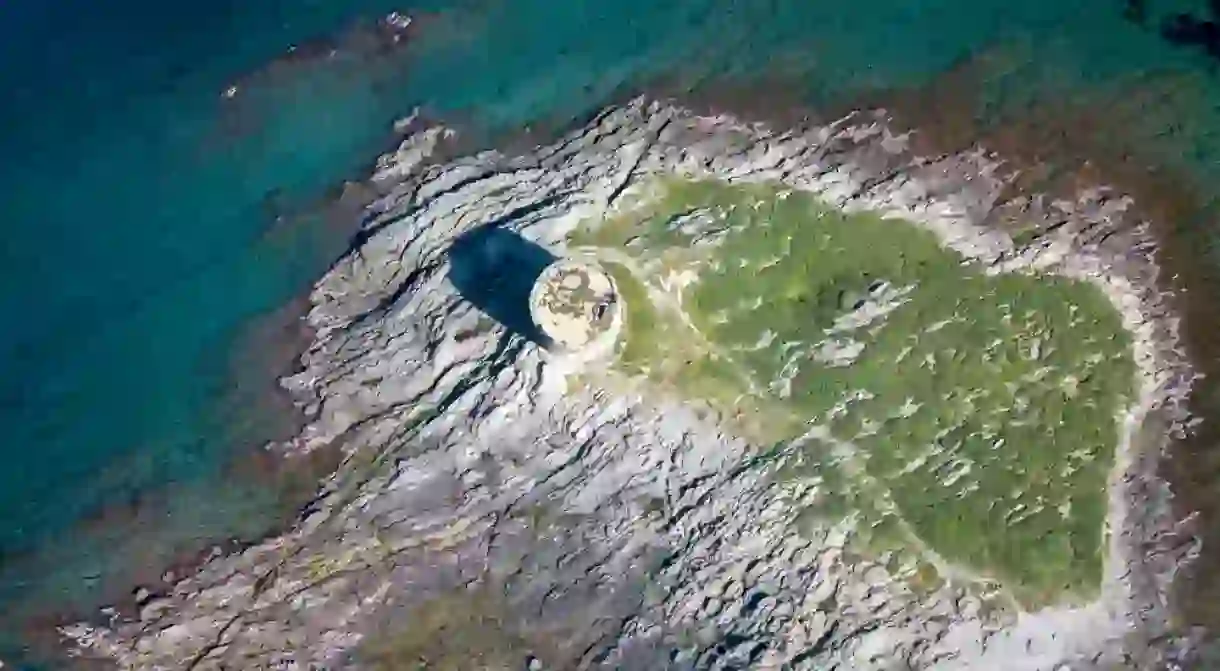The 12 Most Surreal and Beautiful Places in Sardinia

The Italian island of Sardinia is filled with natural wonder. Its turquoise Mediterranean water and miles of beaches are the main draws, but its mysterious ancient structures, hiking trails and colourful mountain towns are also worth discovering. From Neptune’s Grotto to Cala Brandinchi, here are our guide for the things to do in Sardinia, Italy.
Neptune's Grotto, for an otherworldly cave
Natural Feature

Take the long seaside staircase escala del cabirol, or “goat steps,” down to this incredible natural wonder near Alghero. The grotto takes its name from Neptune, the Roman god of the sea. Inside you’ll find a large saltwater lake and both stalactites and stalagmites that create an otherworldly experience. If you don’t fancy climbing down (and up) the 656 steps, and if the water is calm, you can take a boat from the harbour in the Port of Alghero.
Argentiera, for a mining ghost town
Natural Feature
This ghost town is a stone’s throw from the university town of Sassari on the western coast of the island. A former mining town dating back to Roman times, Argentiera is now part of a Unesco-protected collection of eight separate areas known as the Parco Geominerario. You can roam the abandoned mine buildings and explore the nearby beaches for an unusual day out.
La Pelosa Beach, for the most beautiful beach in Sardinia
Natural Feature

While it is virtually impossible to name just one beach as the most beautiful beach in Sardinia, La Pelosa Beach in Stintino is without a doubt one of them. Calm turquoise waters and soft sugar-white sand are banked on one side, with lush Mediterranean vegetation and a view of the island of Asinara on the other. There is also a charming 17th-century tower thrown in the mix for good measure.
Murals of Orgosolo, for creative street art
Architectural Landmark

In the isolated and rugged mountain region known as the Barbagia, there is a town that has always had a strong and independent voice. The buildings in the town of serve as a canvas to broadcast the thoughts and will of the inhabitants. The practice began in the 1960s and grew. Today, you will find political statements and depictions of daily village life expressed in large-scale murals.
Su Nuraxi di Barumini, for ancient archeology
Archaeological site
The mysterious and ancient structures that are known as Nuraghe are scattered all over Sardinia. The Su Nuraxi is part of the Barumini archaeological site and is considered by experts to be one of the finest examples of Bronze Age civilization villages. This site has been listed as a Unesco World Heritage site.
Gola di Gorropu, for hiking in canyons
Natural Feature
Located in a vast chasm on the Supramonte mountain, the Gola di Gorropu is often called Italy’s Grand Canyon. Almost 1,500ft (457m) down and a mile (just under 2km) wide, this place offers trails to hike and rivers to raft and swim in. If you believe in myths, keeps your eyes out for Sa Mama de Gorropu, Sardinia’s very own Bigfoot.
Capo Testa, for scenic views
Natural Feature

At Capo Testa, up in north Sardinia, wind has sculpted granite boulders into soft shapes, and the water is deep and crystal clear. At the nearby Cala dei Corsari, the water is indeed so clear that you can spot submerged Roman-era columns. The end of the day, as the sun slowly sinks into the horizon, is particularly scenic here.
Mamoiada, for a unique cultural carnival experience
Natural Feature

This town, nestled in the Barbagia hills, is best known for its carnival costumes and masks worn by the mamuthones, who wear black leather and large bells, and issohadores, who wear hats called berrittas and distinctive red-and-black outfits. Also of note is a carved granite stone sculpture, the Menhir of Perda Pinta, which dates back to 3200 BCE.
Santa Teresa Gallura, for epic Sardinian scenery
Natural Feature

Located on a narrow strip of land, on the Strait of Bonifacio, Santa Teresa Gallura is an oasis of greens and blues, replete with vegetation, granite boulders and clear, cool seas. Find a beach with a view of the nearby French island of Corsica or visit the Giants’ Tomb, a megalithic archaeological site dating back to the Bronze Age. In the summer season, the town’s main piazza is abuzz with shops and restaurants.
Castelsardo, for a picture-perfect pretty town
Natural Feature

This town on the northwest coast of the island shows up on a lot of “prettiest towns in Italy” lists with good reason. With a castle, beautiful beaches and spa hotels, there is a lot to like about Castelsardo. Other highlights here include the rock formation known as the Roccia dell’Elefante and the interesting Museo dell’Intreccio Mediterraneo, which is dedicated to the island art of basket weaving.
Tempio Pausania, for elaborate carnival floats
Natural Feature
For three days in midwinter, the sleepy town of Tempio in northern Sardinia transforms with lively and colourful festivities. Carnival in Tempio Pausania is celebrated with parades, elaborately decorated floats and masked performers on foot and horseback. You will likely spot Lu Linzolu Cupaltatu, a mysterious female figure who walks along the streets completely wrapped in a sheet, and Ghjolghju Puntogliu, the enormous masked figure who marks the end of the celebrations and the beginning of Lent.
Cala Brandinchi, for a beach lover's paradise
Natural Feature

This beach is so beautiful that locals call it Little Tahiti. Bounded by a cool pine forest on one side and turquoise water on the other, the soft white sand completes the paradise effect. There are private beach clubs that rent out sun loungers and umbrellas.
Trips and Tours in Italy
Architectural Landmark

Planning your holidays in Italy? Don’t forget to check out or diverse collection of multi-day tours all over the country, from hiking in the Dolomites and cycling through Tuscany, to eating your way through Sicily. Delicious.













